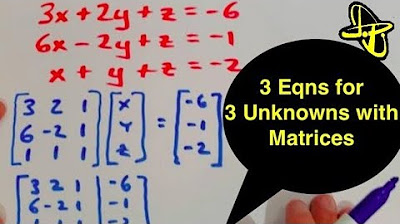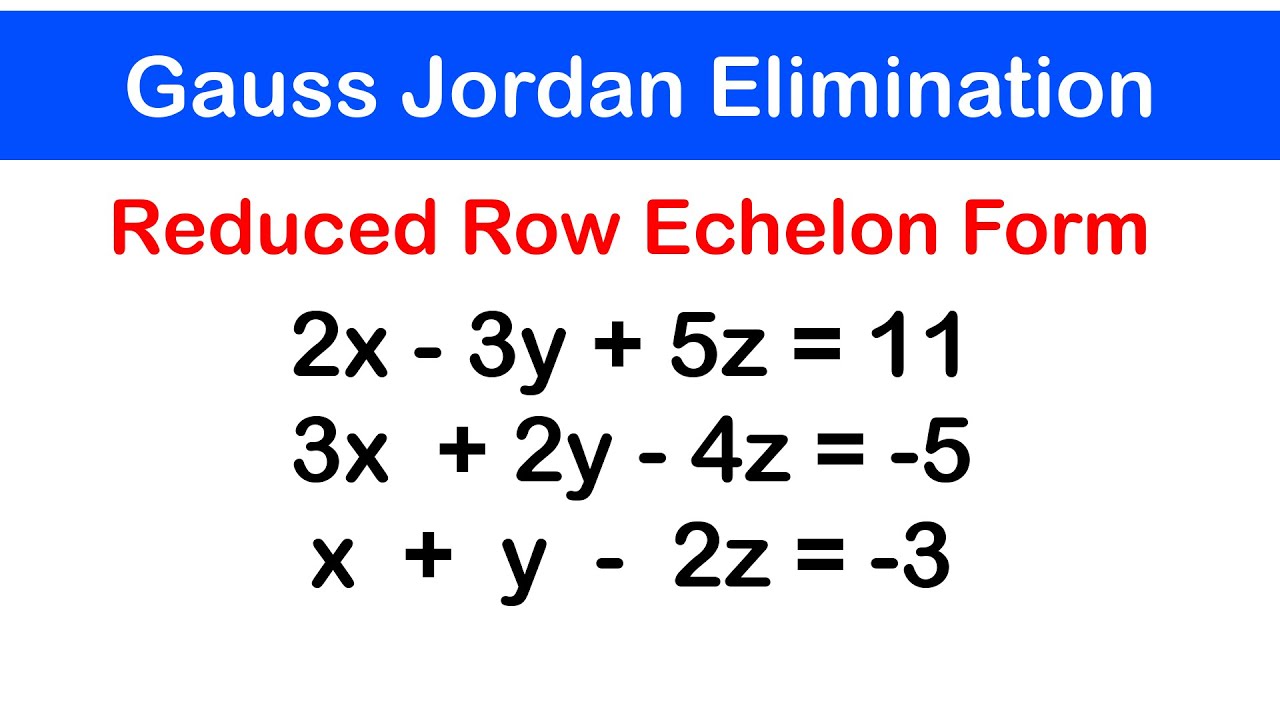Matrices: Reduced row echelon form 2 | Vectors and spaces | Linear Algebra | Khan Academy
TLDRThe video script outlines a step-by-step process of solving a system of three linear equations with three unknowns using the method of reduced row echelon form. The presenter converts the system into an augmented matrix, performs a series of row operations to achieve the desired form, and ultimately translates the resulting matrix back into a set of solutions for the variables x, y, and z. The detailed explanation is aimed at providing clarity and reinforcing the understanding of this fundamental mathematical technique.
Takeaways
- 📚 The speaker is practicing solving systems of linear equations using augmented matrices and reduced row echelon form.
- 🔢 The system has three equations with three unknowns (x, y, z) and coefficients of (1, 1, 1) for x terms, (1, 2, 3) for y terms, and (1, 3, 4) for z terms, with constants (3, 0, -2).
- 🎯 The goal is to transform the augmented matrix into reduced row echelon form, which requires pivot entries in the correct positions and all other entries in a column below a pivot to be zero.
- 🚫 The first step involves eliminating entries below the leading 1 in the first column by subtracting the first row from the other rows.
- 🔄 The process continues with creating a pivot entry in the second row's second column by eliminating the entry directly below it.
- 📈 After obtaining the desired pivot structure, the speaker aims to adjust the entries above the last pivot to be zero, using similar row operations.
- 🔢 The final form of the matrix has the pivot entries as the only non-zero entries in their respective columns, with each pivot to the right of the previous one.
- 💡 The speaker emphasizes the importance of careful calculations to avoid mistakes throughout the process.
- 📝 The solution to the system is derived from the final matrix, with x, y, and z coefficients corresponding to the constants in the reduced row echelon form.
- 📋 The final solution is presented in a clear and organized manner, with each equation corresponding to a row in the reduced matrix.
- 🌟 The method demonstrated is a valuable approach to solving systems of linear equations, showcasing the power of matrix operations in finding solutions.
Q & A
What is the method used to solve the system of linear equations in the script?
-The method used is solving the system using an augmented matrix and transforming it into reduced row echelon form.
How many unknowns and equations are in the system being discussed?
-There are three unknowns and three equations in the system.
What are the coefficients of the x terms in the augmented matrix?
-The coefficients of the x terms are 1, 1, and 1.
What are the coefficients of the y terms and what do they represent?
-The coefficients of the y terms are 1, 2, and 3, representing the coefficients of y in each of the three equations.
What does the speaker do to get the augmented matrix into reduced row echelon form?
-The speaker performs a series of row operations, including replacing rows with the result of other rows combined through addition or subtraction, to create a pivot entry in each column and zero out non-pivot entries below the pivots.
What is a pivot entry in the context of reduced row echelon form?
-A pivot entry is a non-zero number that is used as a reference point for further row operations. In reduced row echelon form, each pivot entry is the first non-zero entry in its column, and they are aligned diagonally from top left to bottom right.
How does the speaker ensure they don't make a careless mistake during the process?
-The speaker double-checks their calculations and the steps they've taken, making sure that each operation leads to the correct result before proceeding to the next step.
What is the final form of the system of equations after using the reduced row echelon form?
-The final form is x + 0y + 0z = 5, 0x + 1y + 0z = -1, and 0x + 0y + 1z = -1, indicating that x = 5, y = -1, and z = -1.
What does the speaker mean by 'free variables' in the context of this problem?
-In this context, 'free variables' refer to variables that do not have a pivot entry in their column. Since every column in the reduced row echelon form has a pivot entry, there are no free variables in this system, meaning unique solutions exist for each variable.
Why is it important to have the pivot entries aligned diagonally from top left to bottom right?
-Having the pivot entries aligned in this manner is a key characteristic of reduced row echelon form, which simplifies the system and makes it easier to interpret and solve for the variables. It ensures that each variable is uniquely determined by a single equation, avoiding any dependency or ambiguity.
How does the process of transforming the augmented matrix into reduced row echelon form help in solving the system of equations?
-The transformation process simplifies the system by creating a clear structure where each variable is isolated in one of the rows, making it straightforward to read off the solutions for each variable directly from the matrix.
Outlines
📚 Solving Linear Equations with Augmented Matrices
The paragraph begins with the speaker's intention to practice solving systems of linear equations using an augmented matrix method. The speaker chooses to transform the matrix into reduced row echelon form and outlines the coefficients of the given equations, which are 1 for the x terms, 1, 2, and 3 for the y terms, and 1, 3, and 4 for the z terms, with the constants being 3, 0, and -2. The process of achieving the reduced form involves a series of row operations, including making all elements below the leading 1 in the first column zero and performing similar operations for the subsequent columns. The speaker emphasizes the importance of accuracy and careful calculation throughout the process. Despite a brief interruption caused by a bird outside, the speaker successfully transforms the matrix, achieving a pivot entry in each column and reaching the desired form.
🎯 Achieving Reduced Row Echelon Form and Solution
In this paragraph, the speaker continues the process of solving the system of linear equations by focusing on getting the augmented matrix into reduced row echelon form. The speaker explains the steps to eliminate variables from the first two rows and to ensure that the third row has a pivot entry of 1. The speaker then describes how to use row operations to achieve a solution, resulting in the equations x + 0y + 0z = 5, 0x + 1y + 0z = -1, and 0x + 0y + 1z = -1. The speaker concludes that these equations represent the solution to the original system of three equations with three unknowns. The paragraph emphasizes the methodical approach to solving the system and the importance of maintaining the correct form for the solution.
Mindmap
Keywords
💡Systems of Linear Equations
💡Augmented Matrix
💡Reduced Row Echelon Form
💡Pivot Entry
💡Row Operations
💡Coefficients
💡Variables
💡Solving Equations
💡Dividing Line
💡Free Variables
💡Row Reduction
Highlights
The speaker emphasizes the importance of practicing solving systems of linear equations.
The method of using an augmented matrix to solve the system is chosen.
The augmented matrix is described as having three unknowns with three equations.
The coefficients for the x, y, and z terms are given as 1, 1, 1; 1, 2, 3; and 1, 3, 4 respectively.
The goal of transforming the augmented matrix into reduced row echelon form is stated.
The first step in the process involves making all elements in the first column below the pivot entry equal to zero.
The second row is modified by subtracting the first row to create a zero in the second entry.
The third row is adjusted to target and zero out the second and third entries in the pivot column.
The speaker corrects the process by replacing the first row with the second row minus the first row to avoid a mistake.
The second row is kept the same, with a pivot entry in the second column.
The third row is modified by subtracting twice the second row to achieve a zero in the third entry of the pivot column.
The speaker emphasizes the importance of avoiding careless mistakes during the process.
The final step involves ensuring that the last row has a positive 1 as the pivot entry and zero in the two columns above it.
The system of equations is solved, with the solution presented in a clear and structured manner.
The speaker concludes by expressing hope that the method was found useful for understanding how to solve systems of linear equations.
Transcripts
Browse More Related Video

Gauss Jordan Elimination & Reduced Row Echelon Form

Gaussian Elimination With 4 Variables Using Elementary Row Operations With Matrices

PreCalculus - Matrices & Matrix Applications (5 of 33) Method of Gaussian Elimination: Example

Solving 3 Equations for 3 Unknowns Using a Matrix in Row Echelon Form

7.3.4 Reduced Row Echelon Form

🔷11 - Gauss Jordan Elimination and Reduced Row Echelon Form
5.0 / 5 (0 votes)
Thanks for rating: